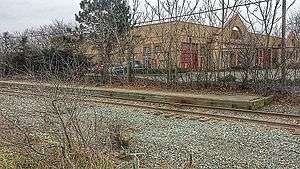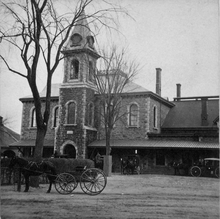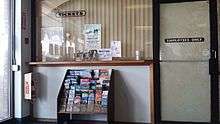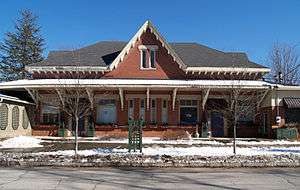Taunton station (Amtrak)
Taunton was a passenger rail station located south of Oak Street in downtown Taunton, Massachusetts. As Taunton Central Station, it served local and Boston-focused routes from 1836 to 1958. A later station at the same site served Amtrak's Cape Codder from 1986 to 1996, and Cape Cod and Hyannis Railroad commuter trains in 1988.
Taunton, MA | |||||||||||||||||||||
|---|---|---|---|---|---|---|---|---|---|---|---|---|---|---|---|---|---|---|---|---|---|
 The 1986-built platform photographed in December 2014 | |||||||||||||||||||||
| Location | 2-10 Oak Street, Taunton, Massachusetts | ||||||||||||||||||||
| Line(s) | Middleboro Subdivision | ||||||||||||||||||||
| Platforms | 1 side platform | ||||||||||||||||||||
| Tracks | 1 | ||||||||||||||||||||
| History | |||||||||||||||||||||
| Opened | August 1836 (New Bedford & Taunton) 1986 (Amtrak) | ||||||||||||||||||||
| Closed | 1958 (New Haven) 1996 (Amtrak) | ||||||||||||||||||||
| Previous names | Taunton Central (until 1958) | ||||||||||||||||||||
| Former services | |||||||||||||||||||||
| |||||||||||||||||||||
History
Taunton Central Station

The New Bedford and Taunton Railroad opened from Mansfield to Taunton in August 1836 - one of the first branch lines in the state.[1] Its Taunton Central Station was located between Oak Street and Wales Street, surrounded by the Taunton Locomotive Manufacturing Company and Mason Machine Works.[2][3]
The line passed to the Old Colony Railroad in 1879 and the New Haven Railroad in 1893. The New Haven operated passenger service through Taunton, including Boston - Fall River and Boston - New Bedford routes, in addition to the seasonal New York - Cape Cod Cape Codder service.[4] Year-round NH passenger service to Taunton ended in 1958.[1] Taunton briefly saw service again, during the summers of 1960 to 1964, when the Day Cape Codder and Neptune returned.[5]
Amtrak and CC&HRR
A new station nearby was built for Amtrak's Cape Codder service from 1986 to 1996. Located off Oak Street next to the GATRA Bloom Bus Terminal (where a ticket counter was located), the station consisted of a single bare asphalt platform serving the single track.[6]

Cape Cod & Hyannis Railroad commuter trains stopped at the station on Attleboro-Cape Cod runs in 1988.[7]
As of 2014 the 1980s-built platform is still extant, though partially covered by vegetation, and the old ticket window could be seen in the Bloom Bus Station that served as the terminal, until a renovation in 2015.
South Coast Rail

At several times during the South Coast Rail planning process, the site was under consideration as a station for MBTA Commuter Rail service to Boston. In September 1995, the MBTA filed an environmental notification form for construction of the project, with a routing following the Northeast Corridor to just north of Attleboro and a new bypass connecting to the branch line to Taunton. The station would have been upgraded to a full-length high-level platform to meet Americans with Disabilities Act requirements.[8] However, further reports suggested a route through Stoughton which would not stop at the station location, and the project was eventually cancelled in 2003.
When planning was restarted in 2005, alternatives through Attleboro and Stoughton were considered. The Stoughton alternate chosen in 2009 included two possible routing options, one following the former Whittenton Branch which would have a station at the Oak Street location. This would have provided convenient transfers to GATRA bus services, but resulted in longer travel times as the Whittenton Branch includes several major curves.[9]
The Final Environmental Impact Statement, released in 2013, selected a route further east with Dean Street station as a downtown stop instead. The FEIS included the possibility of using the Whittenton Branch, but a station would have been built at Dana Street several blocks to the north of the Oak Street location, where the straighter track geometry would be more favorable for the construction of full-length high-level platforms.[10]
References
- Karr, Ronald Dale (1995). The Rail Lines of Southern New England. Branch Line Press. pp. 327–330. ISBN 0942147022.
- "City of Taunton". Official Topographical Atlas of Massachusetts. Walling & Gray. 1871 – via Ward Maps.
- "City of Taunton". Atlas of Massachusetts. Walker Lithograph & Publishing Co. 1891 – via Ward Maps.
- New Haven timetable, April 24, 1955, Tables 19, 29 https://upload.wikimedia.org/wikipedia/commons/f/fc/New_Haven_Railroad_1955_timetable.pdf
- "The New Haven Railroad, Table 6a". Official Guide of the Railways. National Railway Publication Company. 94 (1). June 1961.
- Amtrak (1 April 1990). "National Train Timetables". Museum of Railway Timetables. p. 9. Retrieved 28 June 2013.
- Belcher, Jonathan (23 March 2013). "Changes to Transit Service in the MBTA district" (PDF). NETransit. Retrieved 28 June 2013.
- Massachusetts Bay Transportation Authority (September 1995). "Environmental Notification Form: Volume I" (PDF). New Bedford/Fall River Commuter Rail Project. Retrieved 7 October 2013.
- South Coast Rail (21 August 2009). "Downtown Taunton Engineering Layout" (PDF). EOT. Retrieved 8 December 2014.
- "Figure 3.2-32 Dana Street Station Conceptual Station Design" (PDF). Volume II: FEIS/FEIR Figures Final Environmental Impact Statement/Final Environmental Impact Report on the South Coast Rail Project proposed by the Massachusetts Department of Transportation. U.S. Army Corps of Engineers New England District. August 2013. Retrieved 8 December 2014.
External links
